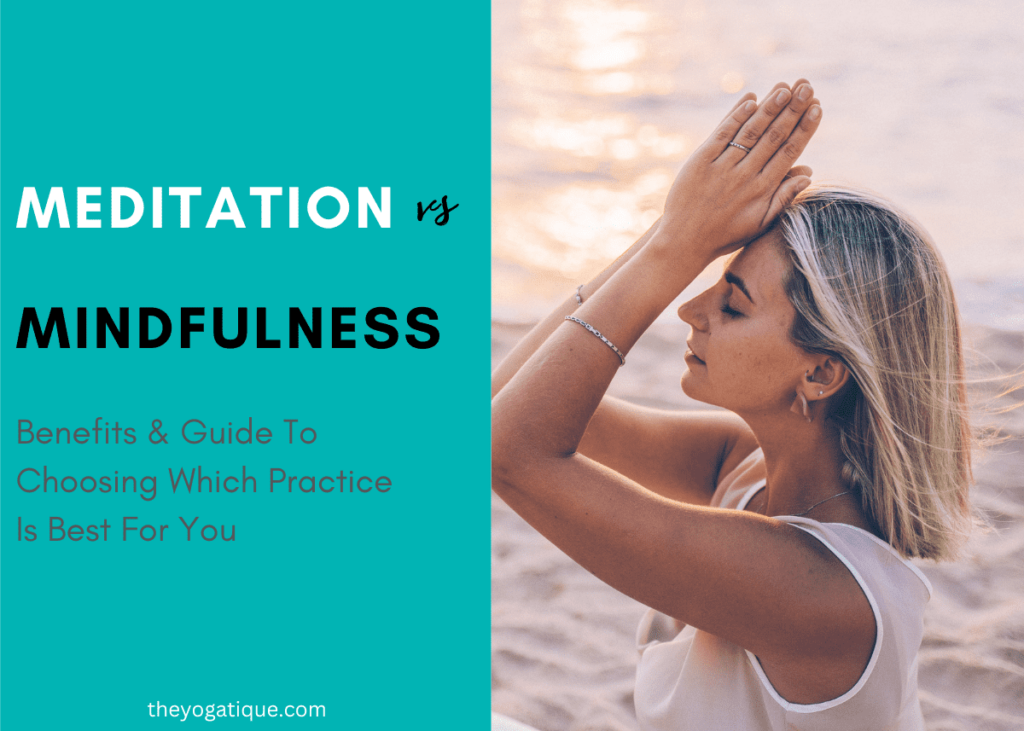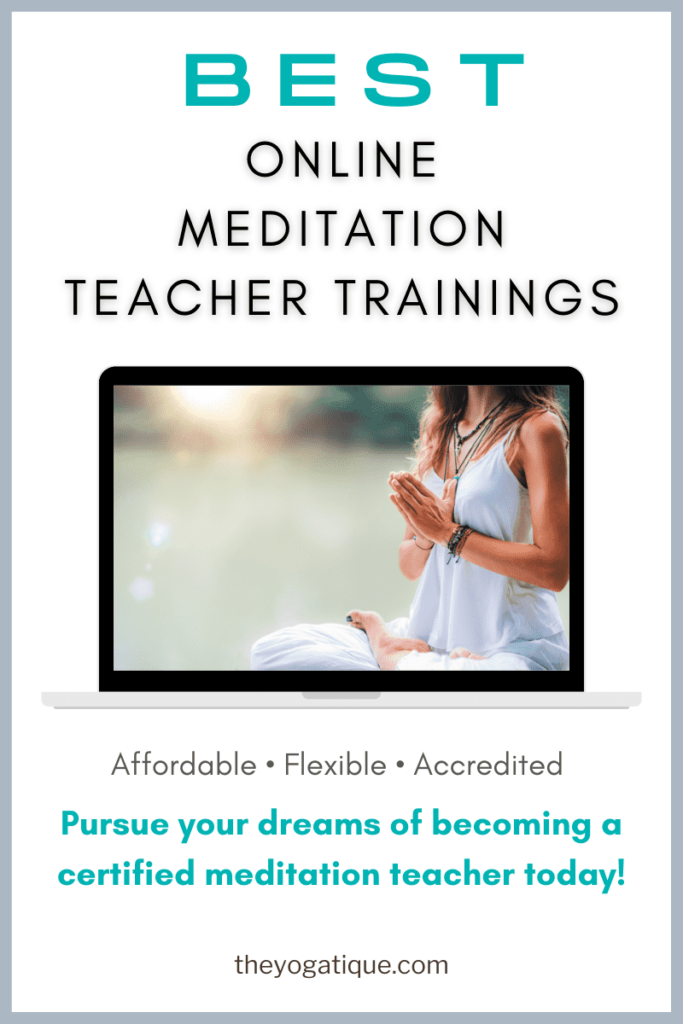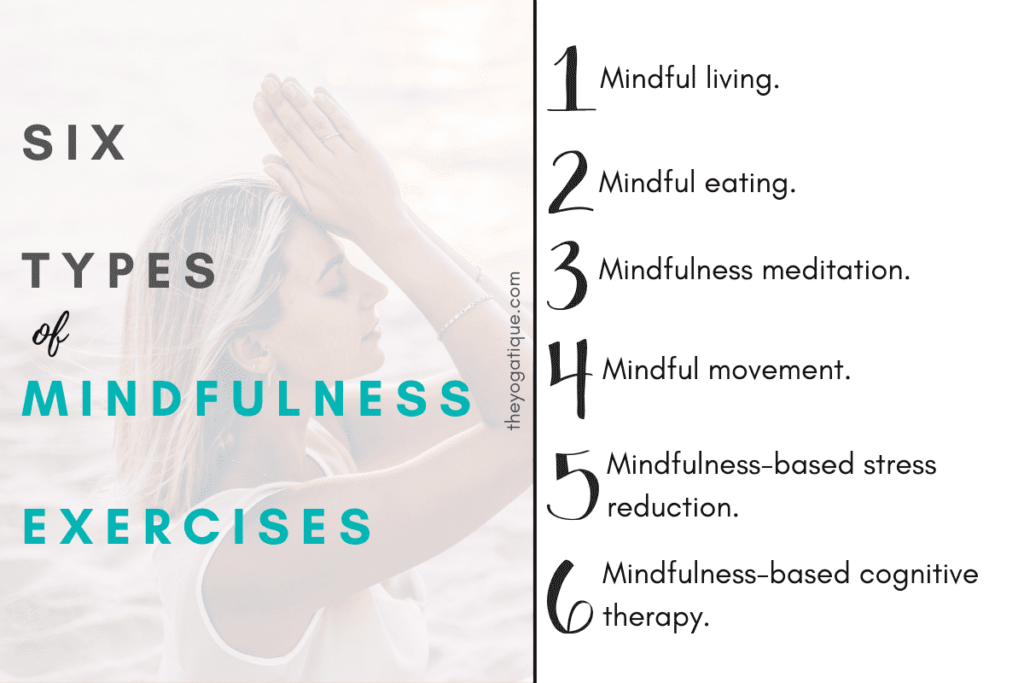
If you're new to the world of yoga and meditation, you may have felt confused at one point or another over meditation vs mindfulness and what the differences between the two really are.
Although these two terms are often used interchangeably, meditation and mindfulness are two different things.
Why is it important to know the difference between them? Well, other than the fact that you need to understand what you are doing for it to be effective, mindfulness and meditation practices have unique benefits and purposes.
In this article, I'll explain the difference between mindfulness and meditation and give clear instructions on practicing both techniques. Let’s dive in!
Article content:
(Click any link below to jump directly to section)

BECOME A CERTIFIED MEDITATION TEACHER
Online Meditation Teacher Training Offers
- Affordability
- Flexibility
- Certification
- Lifetime access
⬇Click below to discover the best online meditation teacher trainings enrolling now⬇
Mindfulness vs meditation: what’s the difference?
The easiest way to explain the difference between meditation vs mindfulness is this – mindfulness is a state of being present and aware, and meditation is a tool we use to access that state.
Meditation is a practice we do to train our minds to become more aware and present. There are various meditation techniques like Vedic meditation and others, but the most common involves sitting with your eyes closed and drawing your awareness within. Meditation practice requires focus and intention to calm the mind.
Mindfulness is a state of being present and aware of your body's sensations and what is going on in your surroundings. It is about being in the present moment rather than stuck in your mind's endless cycle of thoughts.
Unlike meditation, you don't have to stop what you are doing to practice mindfulness. You can practice mindfulness anywhere and anytime, including during everyday activities.
Thus, meditation is not a type of mindfulness but rather a tool for getting into a mindful state.
Similarities between mindfulness and meditation
The most significant similarity between meditation and mindfulness is that they both have many positive benefits for our mental health and well-being. This is because they both direct our awareness away from our “wandering mind” and to our body and our surroundings, bringing us into the present moment.
Meditation & mindfulness offer the following 4 benefits:
- Mental clarity – As we cultivate awareness of our breath, we can detach from our monkey mind and its many scattered and repetitive thoughts. This can provide clarity, improved concentration, and a sense of mental stillness and spaciousness.
- Stress-reduction – There has been much scientific research on the effects of meditation and mindfulness on stress. Research suggests that both practices can significantly reduce stress by lowering high blood pressure and reducing high cortisol levels.
- Improved sleep quality – Other studies show that practicing meditation and mindfulness may improve your sleep quality and reduce sleep disturbances like insomnia.
- Self-development – Mindfulness and meditation promote self-development by increasing self-awareness and emotional balance. These practices teach us how to regulate our thoughts and emotions and practice kindness and compassion towards ourselves and others.
What is mindfulness?
Zen master Thich Nhat Hanh defines mindfulness as “the capacity to be aware of what is going on and what is there.” He also states that there are five steps to mindfulness practice.
While it only gained popularity in the Western world during the 21st century, mindfulness originated from ancient Eastern and Buddhist traditions. Thus, the actual practice is around 2500 years old, even though mindfulness techniques used in clinical psychology, like MBSR (Mindfulness-Based Stress Reduction), were developed in the late 1900s.
The 5 steps of a mindfulness practice:
- Mindful breathing: Deep breathing, paying attention to each inhale and exhale.
- Concentration: Maintaining focus on the breath, following each in-breath and out-breath through to the end.
- Body awareness: Becoming aware of your body through your breath, such as feeling the movement of your belly and chest as you breathe in and out.
- Releasing tension: Observing any tension in your body and releasing it as you breathe out.
- Walking meditation: Once you have a basic understanding of the previous steps, you can apply them while you are moving, whether walking or during everyday life.
6 types of mindfulness exercises

There are various ways you can cultivate mindfulness. Most of them are techniques you can use throughout the day, but some mindfulness styles (MBSR & MBCT) are clinical methods used in psychological medicine, delivered as a series of sessions.
These are some examples of mindfulness exercises:
- Mindful living: To practice mindfulness in your daily life, you bring your full awareness to the task you're doing rather than thinking about something unrelated.
- Mindful eating: You can bring mindfulness to your meal times by eating intentionally and with full awareness. Rather than eating as you watch TV or scroll through your phone, focus solely on the act of eating. Connect to your senses, smelling and tasting the food and feeling its texture in your mouth.
- Mindfulness meditation: Practicing mindfulness meditation means you pause what you are doing, sit down, and bring your focus to your breath, senses, and bodily sensations.
- Mindful movement: This could be an intentional walk where you pay attention to each step you take, like in Buddhist walking meditation or practicing a mindful activity like yoga or Tai Chi. The key is to keep your awareness of your body and breath as you move.
- Mindfulness-based stress reduction: This is an eight-week, evidence-based intensive mindfulness training program developed by Professor Jon Kabat-Zinn. MBSR has many mental health benefits, such as helping with PTSD (post-traumatic stress disorder) and anxiety disorders. It involves breathing techniques, mindfulness meditation, journaling, and group sharing.
- Mindfulness-based cognitive therapy: This clinical program is similar to MBSR, mainly used to treat depression. It combines cognitive behavioral therapy with mindfulness meditation and yoga.
How to practice daily mindfulness
To practice mindfulness in your everyday life, start by choosing one or two mundane tasks or chores you do daily. Every time you do this task, consciously draw your attention to what you are doing, bringing total awareness to each part of the process.
You can incorporate mindfulness into:
- Making tea or coffee
- Taking a shower
- Brushing your teeth
- Cooking
- Washing the dishes
For example, if you are making a coffee, become aware of the aroma of the coffee brewing, the sound of the spoon hitting the mug as you stir, and the sensation of the hot cup against your skin.
Try to involve all your senses and stay present for the entire task. If you notice your mind wanders, simply observe it and, without judging, bring your attention back to your intentional practice.
What is meditation?
Meditation is a practice of training yourself to be more aware and present. You can do various meditation techniques, but the general method is to focus your attention on something, such as the breath or a mantra.
Traditionally, you practice meditation in a seated cross-legged position with closed eyes. You often start by becoming aware of the breath, using this to draw your attention inwards.
In the modern world, most people meditate to clear their minds, reduce stress, or experience inner peace amidst their fast-paced lifestyle. However, meditation is an ancient practice believed to originate in Asia thousands of years ago. Historically, it was used as a path to enlightenment.
5 common types of meditation
As meditation has been used in multiple spiritual traditions for centuries, there are many different meditation practices, such as:
- Breath awareness meditation: This familiar and formal meditation style encompasses techniques from various schools of meditation, such as vipassana and zen (see below). Here, the focal point is the breath; the aim is to stay aware of your natural breathing and direct your attention back to the breath whenever the mind wanders.
- Zen meditation: Zen meditation is similar to mindfulness, but it is not mindfulness per se. This meditation technique comes from the Buddhist tradition and involves focusing on the present moment. However, you use your breath as a tool to become present, often counting the inhales and exhales to prevent the mind from wandering.
- Mantra meditation: Mantra meditation comes from both Hindu and Buddhist traditions. It involves reciting a specific sacred mantra either aloud or mentally. In this technique, the mantra serves as the focal point. Many people use mala beads to count their repetitions, often aiming for 108 recites, as it is a sacred number.
- Transcendental meditation: Transcendental is a mantra-based meditation. Rather than choose a mantra yourself, your teacher gives you one, which you then recite silently for 15-20 minutes twice a day.
- Metta meditation: Also known as loving-kindness meditation, this Buddhist meditation technique involves sending love and kindness to yourself and others by reciting positive phrases. It helps to cultivate compassion and empathy and opens the heart to giving and receiving love freely.
How to practice daily meditation
To cultivate a daily meditation practice, choose a time that works for you, such as in the morning before work or at night, and start small. As with building any habit, practicing at the same time each day and having realistic goals are essential.
Start small, aiming for just a few minutes each day to avoid overwhelming yourself. As you get into a routine, you can increase the duration, ideally up to 15 or more minutes.
Another essential aspect of building a daily meditation practice is ensuring you are comfortable. Meditate in a quiet, distraction-free room and invest in a high-quality meditation cushion.
Remember that although the traditional meditation posture is a cross-legged seated position, you should find what works for you. You can sit against a wall with your legs stretched out or on a chair if needed.
If you are doing meditation for the first time, follow a guided practice. You can find many guided meditations on Youtube and meditation apps like Insight Timer, Calm & Headspace.
Here are links to 3 of my favorite beginner-friendly meditations on YouTube to get you started:
- Breath meditation: A fantastic introduction to bringing awareness to your body and breathing and staying present by counting your breaths.
- Metta meditation: A soothing and healing 10-minute guided practice to send love to yourself and others.
- Om meditation: 11 minutes of chanting the simple mantra ‘Om' to bring calm and peace to your mind and body.
Takeaway on meditation vs mindfulness
I hope this article has cleared up any confusion you had around meditation vs mindfulness. Whether you practice mindfulness, meditation, or both, introducing these healthy habits will bring noticeable benefits to your mental health and well-being. You can learn more about meditation and mindfulness practices in an online meditation teacher training program. Enjoy!
Some online yoga studios, online yoga teacher training programs, and brands that we write about may offer us a small commission should you decide to make a purchase or signup after reading our content. Thank you for enabling us to exist!






